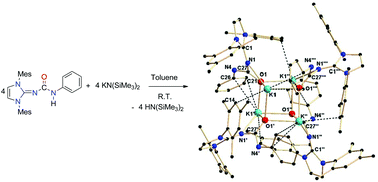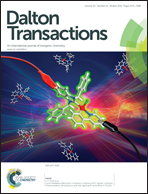Imidazol-2-ylidene-N′-phenylureate ligands in alkali and alkaline earth metal coordination spheres – heterocubane core to polymeric structural motif formation†
Abstract
The synthesis and isolation of two potassium, one lithium and two calcium complexes of imidazol-2-ylidene-N′-phenylureate ligands [ImRNCON(H)Ph] [(R = tBu (1a); Mes (1b) and Dipp (1c); Mes = mesityl, Dipp = 2,6-diisopropylphenyl] are described. Potassium complexes, [{κ2-(ImMesNCONPh)K}4] (2b) and [{κ3-(ImDippNCONPh)K}2{KN(SiMe3)2}2]n (2c), were prepared in good yields by the reactions of 1b and 1c, respectively, with potassium bis(trimethyl)silyl amide at ambient temperature in toluene. Lithium complex [{(2,6-tBu2-4-Me-C6H2O)Li(ImtBuNCON(H)Ph)}2{ImtBuNCON(H)Ph}] (3a) was isolated by a one-pot reaction between 1a and LiCH2SiMe3, followed by the addition of 2,6-tBu2-4-Me-C6H2OH in toluene. Calcium complex [{κ2-(ImtBuNCONPh)Ca{N(SiMe3)2}-{KN(SiMe3)2}]n (4a) was isolated by the one-pot reaction of 1a with [KN(SiMe3)2] and calcium diiodide in THF at ambient temperature. The solid-state structures of ligand 1a and complexes 2b, 2c, 3a and 4a were confirmed by single-crystal X-ray diffraction analysis. It was observed that potassium was coordinated to the oxygen atom of urea group and to the nitrogen atom of the imidazolin-2-imine group, in the solid-state structure of 2b. In complex 4a, the calcium ion was ligated to the monoanionic imidazol-2-ylidene-N′-phenylureate ligand in a bi-dentate (κ2) fashion through the oxygen and nitrogen atoms of the isocyanate building block leaving the imidazolin-2-imine fragment uncoordinated. In the solid state of the potassium complex 2c, tri-dentate (κ3) coordination from the imidazol-2-ylidene-N′-phenylureate ligand was observed through the oxygen and nitrogen atoms of the isocyanate building block and of the imidazolin-2-imine fragment. In contrast, in the dimeric lithium complex 3a, the neutral imidazol-2-ylidene-N′-phenylureate ligand was bound to the lithium centre in a mono-dentate fashion (κ1) through an oxygen atom of the isocyanate moiety. It is to be noted that in each complex thus observed, the elongated carbon–nitrogen bond distances indicate substantial electron delocalisation from the imidazole ring to the ureate group present in ligand 1.



 Please wait while we load your content...
Please wait while we load your content...